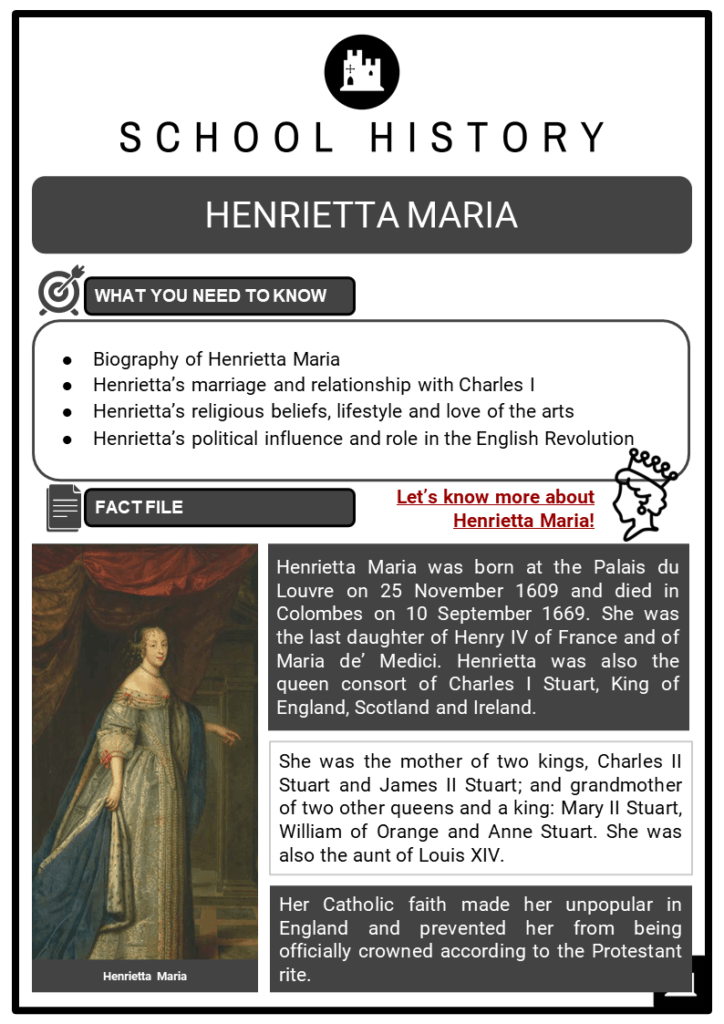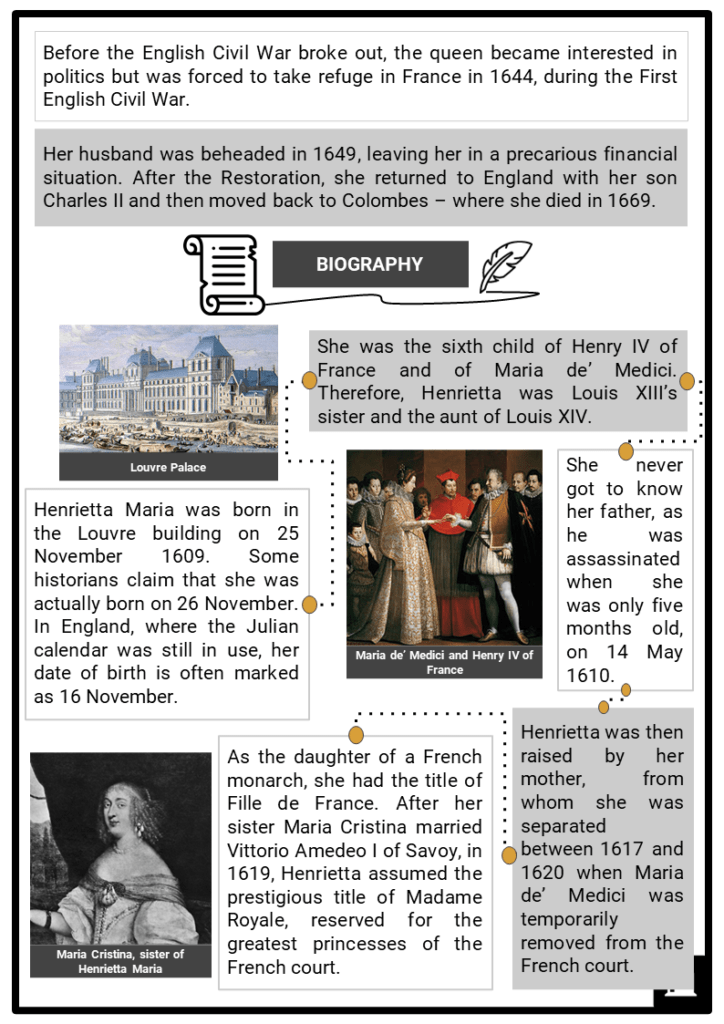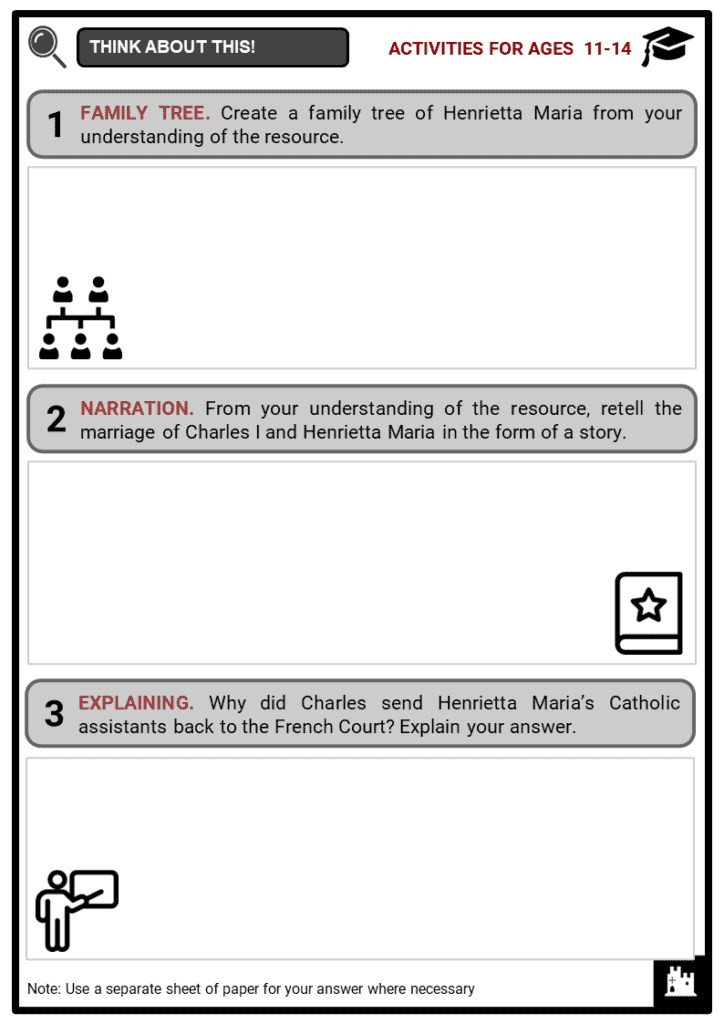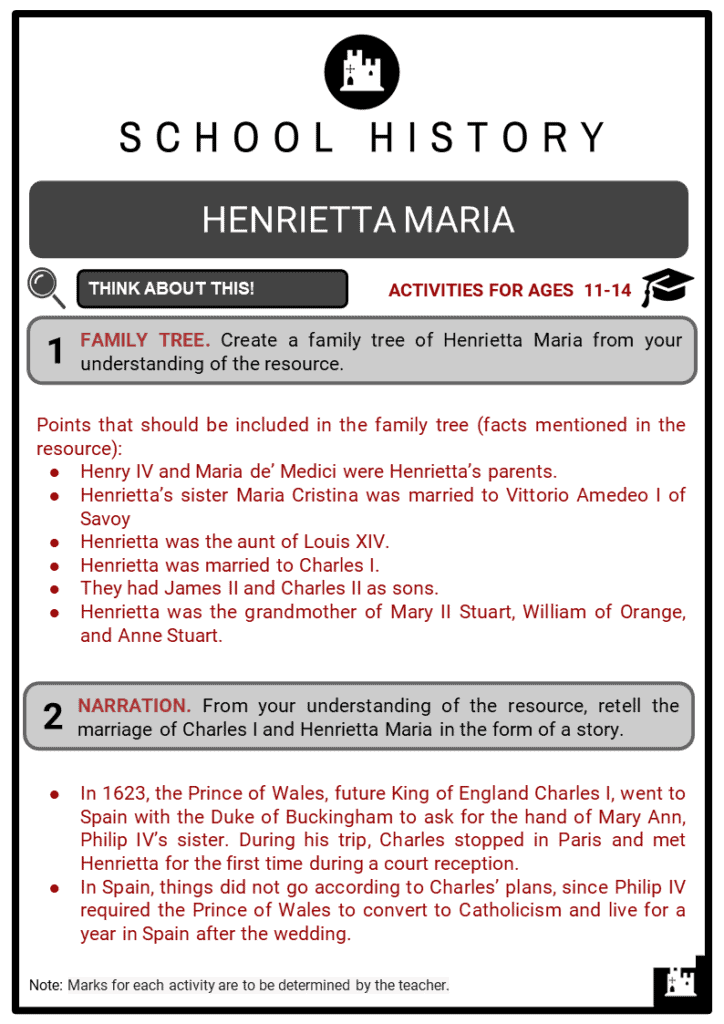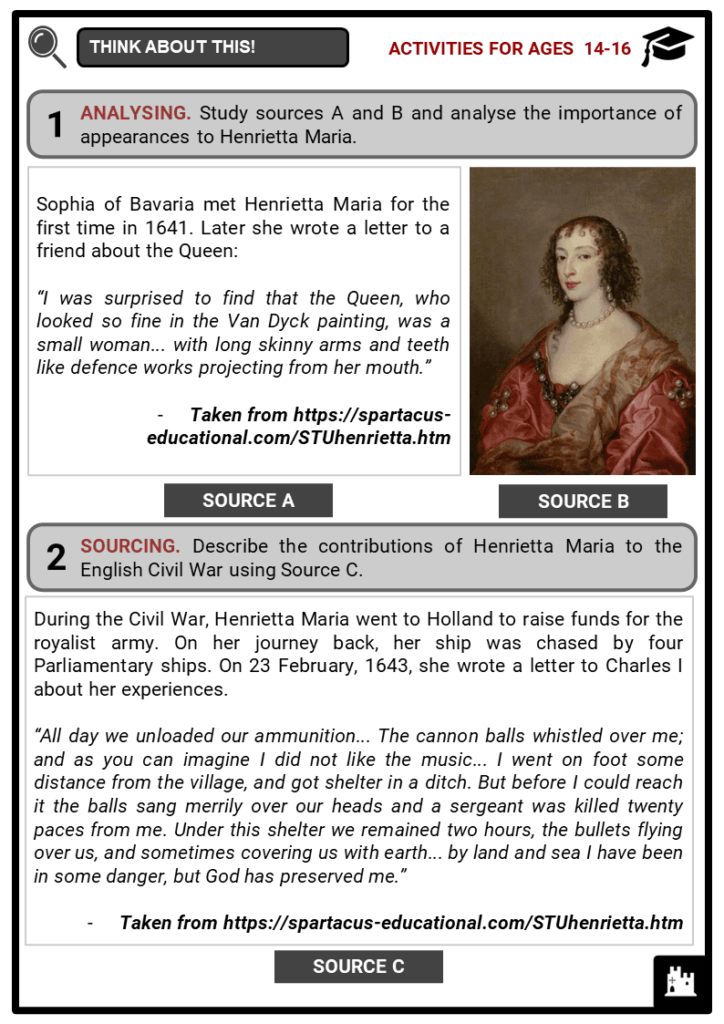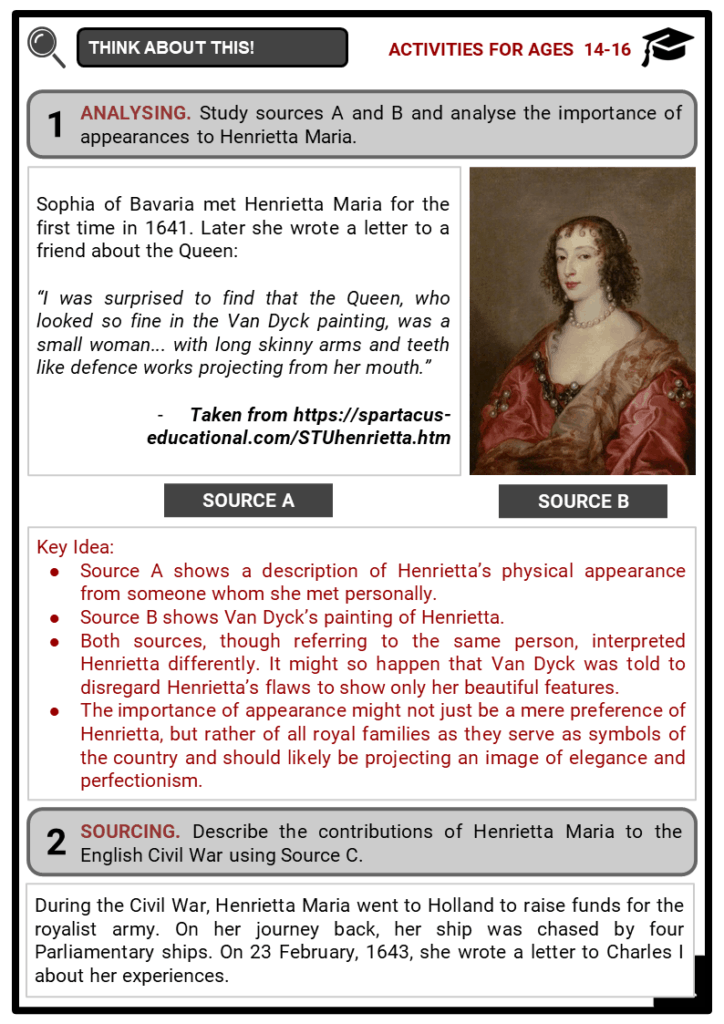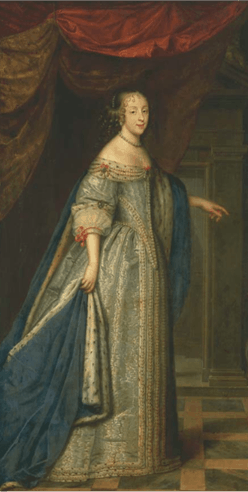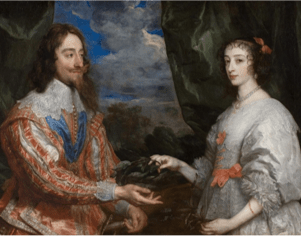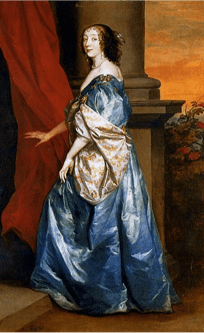Download Henrietta Maria Worksheets
Do you want to save dozens of hours in time? Get your evenings and weekends back? Be able to teach Henrietta Maria to your students?
Our worksheet bundle includes a fact file and printable worksheets and student activities. Perfect for both the classroom and homeschooling!
Table of Contents
Add a header to begin generating the table of contents
Summary
- Biography of Henrietta Maria
- Henrietta’s marriage and relationship with Charles I
- Henrietta’s religious beliefs, lifestyle and love of the arts
- Henrietta’s political influence and role in the English Revolution
Key Facts And Information
Let’s know more about Henrietta Maria!
- Henrietta Maria was born at the Palais du Louvre on 25 November 1609 and died in Colombes on 10 September 1669. She was the last daughter of Henry IV of France and of Maria de’ Medici. Henrietta was also the queen consort of Charles I Stuart, King of England, Scotland and Ireland.
- She was the mother of two kings, Charles II Stuart and James II Stuart; and grandmother of two other queens and a king: Mary II Stuart, William of Orange and Anne Stuart. She was also the aunt of Louis XIV.
- Her Catholic faith made her unpopular in England and prevented her from being officially crowned according to the Protestant rite.
- Before the English Civil War broke out, the queen became interested in politics but was forced to take refuge in France in 1644, during the First English Civil War.
- Her husband was beheaded in 1649, leaving her in a precarious financial situation. After the Restoration, she returned to England with her son Charles II and then moved back to Colombes – where she died in 1669.
Biography
- She was the sixth child of Henry IV of France and of Maria de’ Medici. Therefore, Henrietta was Louis XIII’s sister and the aunt of Louis XIV.
- Henrietta Maria was born in the Louvre building on 25 November 1609. Some historians claim that she was actually born on 26 November. In England, where the Julian calendar was still in use, her date of birth is often marked as 16 November.
- She never got to know her father, as he was assassinated when she was only five months old, on 14 May 1610.
- As the daughter of a French monarch, she had the title of Fille de France. After her sister Maria Cristina married Vittorio Amedeo I of Savoy, in 1619, Henrietta assumed the prestigious title of Madame Royale, reserved for the greatest princesses of the French court.
- Henrietta was then raised by her mother, from whom she was separated between 1617 and 1620 when Maria de’ Medici was temporarily removed from the French court.
- Along with her sisters, the princess was educated in a cultured and refined environment, learning the arts of horse riding, singing and dancing. However, they were not particularly suitable for the classical studies given by the Carmelites, who instilled in them a profound faith in Roman Catholicism.
Henrietta’s Marriage With Charles I
- In 1623, the Prince of Wales, future King of England Charles I, went to Spain with the Duke of Buckingham to ask for the hand of Mary Ann, Philip IV’s sister. During his trip, Charles stopped in Paris and met Henrietta for the first time during a court reception.
- In Spain, things did not go according to Charles’ plans, since Philip IV required the Prince of Wales to convert to Catholicism and live for a year in Spain after the wedding.
- On the other hand, Henrietta was a pretty sixteen-year-old girl with delicate skin and magnetic eyes. Charles brought a precious trunk from England as a marriage offering, which included diamonds, pearls, rings, satin and velvet dresses, embroidered cloaks, skirts and velvet hats.
- Henrietta married Charles by proxy in Paris on 11 May 1625, shortly after her accession to the throne. The official marriage was celebrated in the church of Saint Augustine in Canterbury on 13 June that same year.
- Since Henrietta was Catholic, it was not possible for her to be crowned queen at the ceremony held on 2 February 1626 in Westminster Abbey, and her proposal to be crowned by the Catholic bishop of Mende was rejected by Charles and the court.
Henrietta’s Religious Beliefs And Lifestyle
- Because of her religious beliefs, the new queen was not fully welcomed in the English court. Charles simply called her Maria, whereas other people referred to her with the title of ‘Queen Mary’, recalling the famous and criticised Catholic queen, Mary Stuart.
- In July 1626, she prayed for the executed Catholics at Tyburn, causing a profound controversy. Henrietta had also brought a large number of Catholic assistants with her from France. On 26 June 1626, Charles sent the group of Catholics back to the French court.
- Some people, including the bishop of Mende, refused to abandon their lady so the king resorted to having his guards expel them. Seeing Henrietta observing the expulsion, Charles dragged her away from the window with force. Of her French retinue, only the chaplain and confessor Robert Phillip and two maids remained.
- Their expulsion was also due to Charles’ intention to limit the expenses of the new queen. In fact, in the early days, Henrietta spent enormous amounts of money and accumulated debts that lasted for several years. Therefore, Charles appointed a new treasurer, Jean Caille, later replaced by George Carew and finally by Richard Wynn in 1629.
- However, even after all these changes, the high expenses continued. In fact, despite her husband’s gifts, Henrietta continued to use the king’s money. When the civil war broke out, her continued and extravagant spending was revealed.
- Her following was composed of many court dwarves, including Jeffrey Hudson (portrayed in a famous Van Dyck painting), small dogs, monkeys and exotic birds. In 1630, Henrietta established the residences of Somerset, Greenwich, Oatlands, Nonsuch, Richmond and Holdenby.
Relationship Between Henrietta And Charles I
- Initially, the relationship between Charles I and Henrietta was cold and the king’s choice to limit his wife’s expenses did not improve the situation. They often fought and tried to stay as far away from each other as possible.
- From the beginning, Henrietta felt an aversion towards the king’s favourite, George Villiers, Duke of Buckingham. Instead, she became friends with Lucy Percy, Countess of Carlisle, wife of James Hay, who had contributed to the negotiations of the queen’s marriage.
- Lucy, who supposedly inspired Alexandre Dumas for the character of Milady, was a brilliant, beautiful woman with a strong personality. At the time, many believed that Villiers tried to control the queen through Lucy. However, relations between the queen and the countess remained good, at least until 1634.
- After the death of Villiers in August 1628, Henrietta’s relationship with her husband Charles I improved and they developed a deep bond. They stopped arguing and began to live as husband and wife in a harmonious environment.
- The queen took the place of Charles’ best friend and adviser, a role filled previously by Villiers. Henrietta became pregnant for the first time in 1628 and the following year, she gave birth. After a difficult delivery, the child died immediately after birth. In 1630, she gave birth to another son, the future Charles II, but this too was a very difficult delivery.
- Henrietta refused to reject her Catholic faith, which alienated her from many people, including some powerful courtiers such as William Laud, Archbishop of Canterbury, and Thomas Wentworth, 1st Earl of Strafford.
Henrietta And The Arts
- Both the queen and her husband were connoisseurs and avid collectors of paintings. Henrietta is particularly known for her support of the Italian painter Orazio Gentileschi, who arrived in England in 1626 together with François de Bassompierre. Another of her favourite painters was Guido Reni and she also financed the miniaturists Jean Petitot and Jacques Bourdier.
- Henrietta strongly supported the theatre. She participated in various performances, such as the Salmacida Spolia (1640) by William Davenant, in which she played the role of an Amazon. She loved music, especially the English composer Nicholas Lanier. Moreover, the queen was interested in sculpture, interior design and gardening.
Political Influence And English Revolution
- Henrietta participated more and more in English politics while the country was heading towards conflict in the 1630s. She allied herself with the Puritan courtiers and plotted against the parliamentarians.
- With the war getting closer, she actively set out to raise funds to help her husband but her desire to turn to Catholic sources like the Pope and the French king angered many in England and hampered Charles’ efforts.
- In August 1642, when the conflict began, Henrietta was in Europe. She continued collecting money for the monarchical cause and did not return to England until the beginning of 1643. She disembarked in Bridlington (Yorkshire) with the troops and soldiers she had managed to gather, and joined the monarchical forces in the north of England.
- She remained with the army in the north for a few months before meeting the king in Oxford. The king lost the civil war when the Scots sided with Parliament. Henrietta’s refusal to accept the strict terms of the peace agreement forced her to flee to France with her children in July 1644. The queen and Charles would never see each other again. The king was executed in 1649, leaving her almost destitute.
- Henrietta never fully recovered from King Charles’ execution and wore mourning clothes for the rest of her life. She first settled in Paris and after the Restoration of her son, Charles II, to the throne, she returned to England. In 1665, however, she moved to Paris where she died four years later in Colombes.
Image sources:

